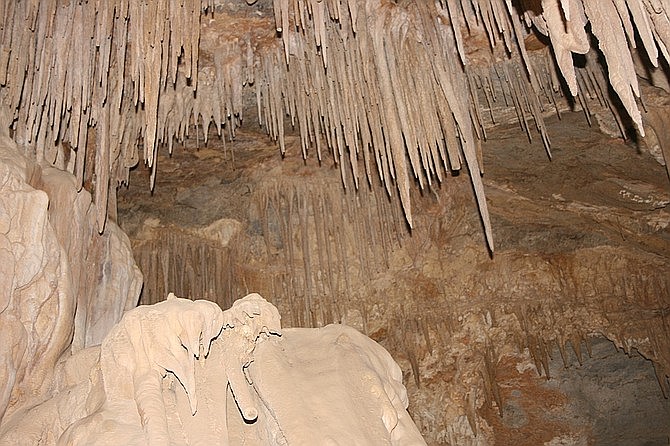 Facebook
Facebook
 X
X
 Instagram
Instagram
 TikTok
TikTok
 Youtube
Youtube

The Mitchell Caverns are not as large as those at Carlsbad, New Mexico, or as well known — but are local, every bit as dramatic, and come complete with a history made for movies.

I had no idea what to expect when I journeyed up over 4,000 feet into the Mojave Preserve of southeastern California in the Providence Mountain Range, and was not quite prepared for the colorful wonderland I found. In a four-hour drive from the metropolis of Los Angeles (4.5 hours from San Diego) I went back to a time when giant sloths and saber-toothed tigers roamed the land.
The countless fossilized sea shells found inside the caverns told me that this desert was once the ocean floor and that as sea levels fell, ground water seeping through from above left tiny lime crusts before dripping to the floor, thus forming the dramatic sculptured stalactites (growing down from the roof) and stalagmites (growing up from the floor) we have all come to know from photos. These caverns are still "living," as water continues to seep through, dripping endlessly and forming more natural sculptures all the time.
I stepped lightly along the trail knowing it was also home to several insects found nowhere else in the world.
We know that the Chemehuevi people considered the caves sacred.
The caverns appeared briefly in the Oliver Stone movie The Doors, but since the film crew defaced them by adding their own "ancient " petroglyphs to the walls for one shot (which proved impossible to remove later, and are still there), filming is no longer allowed in them. Because of their fragility I was reminded several times not to touch anything and to stay on the path. Even the oils from the touch of a finger can have consequences in such an environment.
I found the entrance, which resembles two large eyes in the rock, by following a meandering trail that offers panoramic views across the valley floor all the way to the Arizona state line.
A large multi-colored chuckwalla darted right in front of me and stopped to do pushups for my camera.
Before entering I read a bronze plaque that told me the caverns first gained public attention when they came under the control of Mr. Jack Mitchell, for whom they are now named. Mitchell was an entrepreneur with businesses in Arizona and Los Angeles and had visited the caverns early in the 20th century, and when he lost his life savings in the stock market crash of 1929 he and his wife Ida retreated to the desert for a simpler life. Mitchell could not buy the caverns outright, so he sidestepped the law by buying up the local mineral rights all around them, effectively giving him control of the caverns.
Mitchell built a small house out of local volcanic rock and decided to capitalize by adding a guest house and charging clients $1 a night for a room (with a 50 cent chicken dinner thrown in) before guiding visitors into the caverns by torchlight. As an added bonus, he built a stone igloo in which a visitor could hear one's voice echo around over and over.
After his death, the caverns entered the State Park system in 1956, where they remain to this day. Jack and Ida’s house is now a visitor center, and the guest cabin is now a residence for park personnel.

The caverns are relatively small, and made me feel as though I had entered a movie set. Dramatic surreal sculptures snaked their way down from the towering roof or ascended majestically from the floor, forming towers, pillars and chandelier-like protrusions that fade in and out of the thin recessed light, while eerie shadows danced about. The towering domed roof spread majestically overhead, causing me to crane my neck constantly as fleet little bats zipped past. I kept a sharp lookout for the ring-tailed cat I was told kept residence there and found his lair, but alas he had gone walkabout during my visit.
Thousands of multicolored stalactites dangle overhead like giant fingers reaching out to caress the visitor and if you look long enough, as I did, you may start to see faces and familiar objects in the rocks.
A cement path made my excursion easy for the most part but since I am large in girth, I had to suck in the old stomach to get past a couple tight spots along the way. Two major sets of caverns are open to the public for tours.
Visitors can only visit the caverns with a ranger guide, so make a reservation in advance. The tour takes about an hour and a half, and most of that is the ranger telling fascinating tales of the history of the caverns. The actual walk through will take about 45 minutes, and flash photography is allowed.
Mitchell Caverns are located in California's Mojave Preserve approximately 80 miles east of Barstow and 60 miles west of Needles. They are 16 miles north of highway 40 with a brown historical landmark sign on the highway at the turnoff. It is developed road all the way there. There are located in the Providence Mountain Range at an elevation of 4,200 feet, and it can be quite cold in the winter and even on windy days in the summer.
You must bring your own food and water. Nearest gas is in the city of Ludlow about 40 miles east. Appropriate footwear is recommended.
See park website for schedule.


The Mitchell Caverns are not as large as those at Carlsbad, New Mexico, or as well known — but are local, every bit as dramatic, and come complete with a history made for movies.

I had no idea what to expect when I journeyed up over 4,000 feet into the Mojave Preserve of southeastern California in the Providence Mountain Range, and was not quite prepared for the colorful wonderland I found. In a four-hour drive from the metropolis of Los Angeles (4.5 hours from San Diego) I went back to a time when giant sloths and saber-toothed tigers roamed the land.
The countless fossilized sea shells found inside the caverns told me that this desert was once the ocean floor and that as sea levels fell, ground water seeping through from above left tiny lime crusts before dripping to the floor, thus forming the dramatic sculptured stalactites (growing down from the roof) and stalagmites (growing up from the floor) we have all come to know from photos. These caverns are still "living," as water continues to seep through, dripping endlessly and forming more natural sculptures all the time.
I stepped lightly along the trail knowing it was also home to several insects found nowhere else in the world.
We know that the Chemehuevi people considered the caves sacred.
The caverns appeared briefly in the Oliver Stone movie The Doors, but since the film crew defaced them by adding their own "ancient " petroglyphs to the walls for one shot (which proved impossible to remove later, and are still there), filming is no longer allowed in them. Because of their fragility I was reminded several times not to touch anything and to stay on the path. Even the oils from the touch of a finger can have consequences in such an environment.
I found the entrance, which resembles two large eyes in the rock, by following a meandering trail that offers panoramic views across the valley floor all the way to the Arizona state line.
A large multi-colored chuckwalla darted right in front of me and stopped to do pushups for my camera.
Before entering I read a bronze plaque that told me the caverns first gained public attention when they came under the control of Mr. Jack Mitchell, for whom they are now named. Mitchell was an entrepreneur with businesses in Arizona and Los Angeles and had visited the caverns early in the 20th century, and when he lost his life savings in the stock market crash of 1929 he and his wife Ida retreated to the desert for a simpler life. Mitchell could not buy the caverns outright, so he sidestepped the law by buying up the local mineral rights all around them, effectively giving him control of the caverns.
Mitchell built a small house out of local volcanic rock and decided to capitalize by adding a guest house and charging clients $1 a night for a room (with a 50 cent chicken dinner thrown in) before guiding visitors into the caverns by torchlight. As an added bonus, he built a stone igloo in which a visitor could hear one's voice echo around over and over.
After his death, the caverns entered the State Park system in 1956, where they remain to this day. Jack and Ida’s house is now a visitor center, and the guest cabin is now a residence for park personnel.

The caverns are relatively small, and made me feel as though I had entered a movie set. Dramatic surreal sculptures snaked their way down from the towering roof or ascended majestically from the floor, forming towers, pillars and chandelier-like protrusions that fade in and out of the thin recessed light, while eerie shadows danced about. The towering domed roof spread majestically overhead, causing me to crane my neck constantly as fleet little bats zipped past. I kept a sharp lookout for the ring-tailed cat I was told kept residence there and found his lair, but alas he had gone walkabout during my visit.
Thousands of multicolored stalactites dangle overhead like giant fingers reaching out to caress the visitor and if you look long enough, as I did, you may start to see faces and familiar objects in the rocks.
A cement path made my excursion easy for the most part but since I am large in girth, I had to suck in the old stomach to get past a couple tight spots along the way. Two major sets of caverns are open to the public for tours.
Visitors can only visit the caverns with a ranger guide, so make a reservation in advance. The tour takes about an hour and a half, and most of that is the ranger telling fascinating tales of the history of the caverns. The actual walk through will take about 45 minutes, and flash photography is allowed.
Mitchell Caverns are located in California's Mojave Preserve approximately 80 miles east of Barstow and 60 miles west of Needles. They are 16 miles north of highway 40 with a brown historical landmark sign on the highway at the turnoff. It is developed road all the way there. There are located in the Providence Mountain Range at an elevation of 4,200 feet, and it can be quite cold in the winter and even on windy days in the summer.
You must bring your own food and water. Nearest gas is in the city of Ludlow about 40 miles east. Appropriate footwear is recommended.
See park website for schedule.
Comments